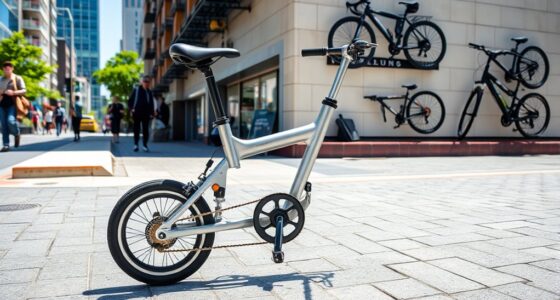To choose the safest route for your city commute, look for well-maintained roads with clear signage and good lighting, especially during early mornings or late nights. Use traffic apps and local reports to avoid congested or accident-prone areas, and select routes with smooth pavement to reduce vehicle risks. Prioritize routes with dedicated bike lanes or sidewalks and stay alert to environmental factors. Stay ahead of hazards and discover more tips to keep your journey safe.
Key Takeaways
- Prioritize well-maintained, well-lit roads with clear signage to enhance visibility and reduce vehicle control issues.
- Use real-time traffic updates to avoid high-accident, congested, or hazardous areas.
- Choose routes with good pavement quality and minimal construction for smoother and safer travel.
- Opt for less congested roads during off-peak hours to decrease risks from reckless driving.
- Select paths with dedicated bike lanes or sidewalks to ensure pedestrian and cyclist safety.

Choosing the safest route for your city commute can considerably reduce your risk of accidents and stress. When you plan your daily travel, you’re taking control of your safety and well-being. Instead of just following the usual path out of habit, it’s worth taking a moment to evaluate different options. Think about the roads you use daily and consider whether they are well-maintained, well-lit, and free of heavy congestion. Avoid routes with frequent accidents, construction, or poor visibility, as these can increase your chances of mishaps.
One of the best ways to identify the safest route is to gather information from local traffic reports and news outlets. These sources often highlight areas prone to accidents or delays. If you notice a particular stretch of road consistently has accidents or heavy congestion, it’s wise to avoid it or plan alternative routes. Also, check online traffic apps that provide real-time updates and alerts. These tools can help you steer clear of accidents, road closures, or unexpected hazards, allowing you to adjust your route proactively.
Pay attention to the road conditions and environment. Choose routes with smooth pavement, good lighting, and clear signage. Well-maintained roads reduce the chances of losing control or damaging your vehicle. Bright street lighting is *indispensable*, especially if you commute early in the morning or late at night, as it enhances visibility and deters criminal activity. Look for routes that avoid isolated or poorly lit areas, making your journey safer and more comfortable.
Choose well-lit, smooth roads with clear signage to ensure a safer, more comfortable commute.
Another *important* factor is traffic volume. Heavily congested roads can lead to impatience, reckless driving, and accidents. If possible, select routes that balance safety and efficiency by avoiding peak hours or busy intersections. Using navigation apps that show live traffic conditions can help you identify less crowded options. Sometimes, a slightly longer route may be safer if it avoids high-risk zones or dangerous intersections.
Lastly, consider the safety of pedestrians and cyclists if you share the road. Opt for routes with dedicated bike lanes or sidewalks, and stay alert for pedestrians crossing at intersections. Be cautious of areas with a high incidence of jaywalking or distracted drivers. Your goal is to choose a route that minimizes exposure to potential hazards while maintaining a reasonable travel time. By staying informed, using technology, and paying attention to road conditions, you can select a route that keeps you safer and less stressed during your daily commute.
Frequently Asked Questions
How Does Weather Impact the Safest Route Choice?
Weather plays a big role in determining your safest route. If it’s rainy or snowy, avoid routes with steep hills or poorly maintained roads that could be slippery. Fog reduces visibility, so pick well-lit, familiar streets. Strong winds might make bridges or open areas dangerous. Always check weather forecasts before your trip and adjust your route accordingly to stay safe and avoid unexpected hazards caused by the weather.
Should I Prioritize Bike Lanes Over Sidewalks?
You should prioritize bike lanes over sidewalks when choosing your route because bike lanes are specifically designed for cyclists, offering a safer, dedicated space away from vehicle traffic. Sidewalks are meant for pedestrians and may not always provide enough space or protection for bikes. By choosing routes with bike lanes, you reduce your risk of accidents and enjoy a more comfortable, secure ride through your city.
How Often Should I Update My Route Preferences?
You should update your route preferences whenever your daily routine or city conditions change. Regularly checking for new bike lanes, construction, or traffic updates helps you stay safe and efficient. If you notice increased congestion or safety concerns on your usual path, consider adjusting your route more frequently. Staying proactive guarantees you’re always using the safest, most convenient routes for your city commute.
What Apps Provide Real-Time Safety Alerts?
Did you know over 60% of commuters rely on apps for safety alerts? You should consider using apps like Waze, which provides real-time traffic and safety notifications, or Nextdoor, where neighbors share local safety updates. These apps keep you informed about accidents, hazards, or crimes nearby. By actively using them, you can adjust your route instantly, ensuring your safety and peace of mind during your daily commute.
How Do I Account for Construction Zones?
You should check your navigation app for construction updates before starting your trip. Many apps display real-time construction zones, so you can plan a route that avoids delays and hazards. Pay attention to alerts and alternate routes suggested by your app. If you see ongoing construction, consider leaving early or taking a different path to stay safe, save time, and reduce stress during your commute.
Conclusion
By choosing the safest route, you substantially reduce your risk of accidents—studies show pedestrians and cyclists face up to 50% fewer injuries when sticking to well-lit, busy streets. Always stay alert, plan ahead, and consider traffic patterns. Remember, your daily choices impact safety for everyone. So, take a few extra minutes to pick the safest path; it’s a simple step that can make your commute safer and more confident each day.









